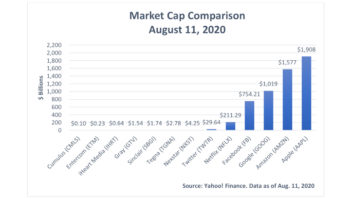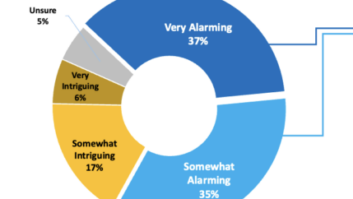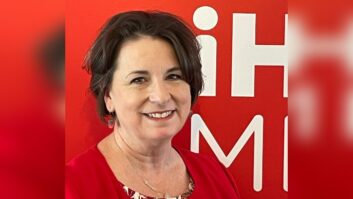The origins of Jacobs Media’s Techsurvey can be traced to the early 2000s when the scale of change in consumer electronics and media consumption was becoming evident.
Fred Jacobs, president of the research and consulting firm, says he had a natural curiosity about how changes in listening habits, devices and platforms affect radio stations.
The rise of the connected car and smart speaker systems like Amazon’s Alexa, Google Home and Apple HomePod are having a significant impact on today’s radio listening environment, as are the podcast movement and other on-demand entertainment options.
However, the online survey also reveals the remarkable steadiness of radio listening levels through the years, even when you consider the radio-centric nature of these non-scientific studies.
So it’s both fun and enlightening to look back at other devices and platforms that were prominent, and when, in years past. Jacobs Media did that in a recent webinar highlighting the survey’s 15 years and the digital transformation that radio and its listeners have experienced over that time.
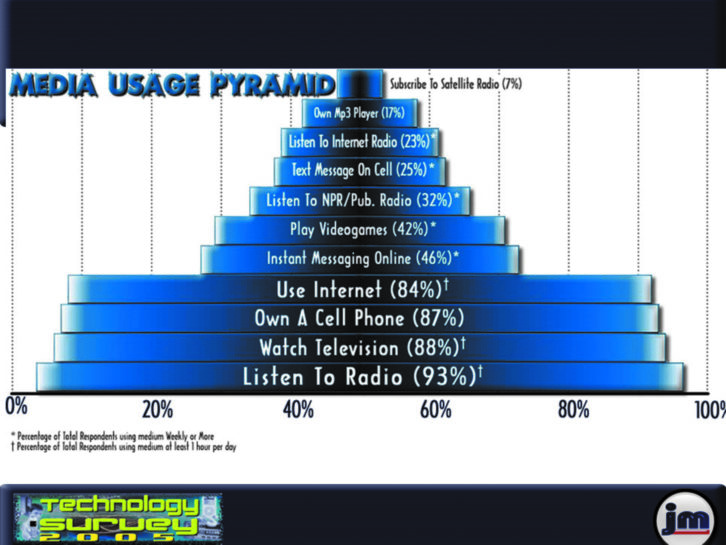
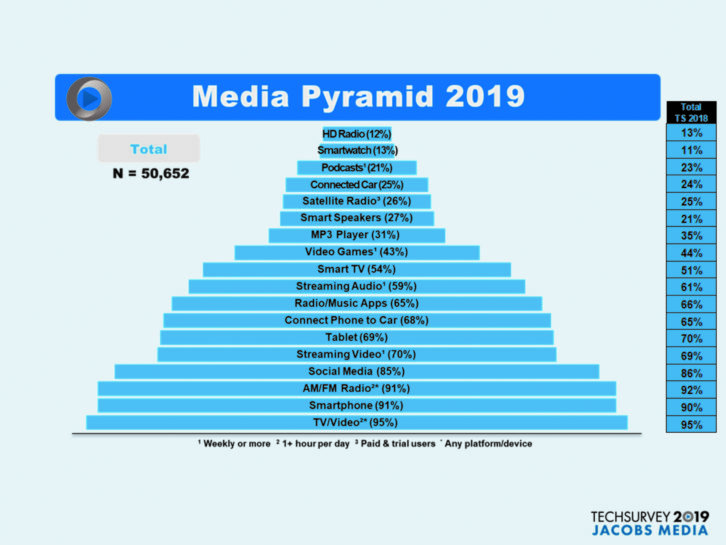
“Our mission with Techsurvey has always been to help radio broadcasters produce a great radio product for their constituencies,” Jacobs said during the webinar.
Techsurvey results parse media usage and tech trends. They are compiled from data collected from listeners of participating radio stations in a variety of formats and are designed to elicit information about those listeners’ technology adoption and usage.
Techsurvey has morphed since its inception from an original focus on the habits of listeners to rock-formatted stations to include those of multiple radio formats, Jacobs said.
The most recent survey in 2019 explored the habits of approximately 64,000 listeners of 560 North American radio stations, according to Jacobs Media.
Techsurvey 2020, for which data gathering began in January, will accompany specific studies for public radio and Christian music broadcasters that Jacobs Media will present later in the year.
EARLY DITCHERS
When the survey began in 2005, its findings reflected those days of flip-phones and internet dialup, Jacobs said.
“There were lots of AOL accounts, and text messaging was just for young people. Only 25% of those surveyed were texting on their phones,” Jacobs said. “Fewer than one in four listened to internet radio, and MP3 players were just coming into vogue.”
An important discovery from the first survey was the number of 18- to 34-year-olds who had already ditched their house landlines and were cell-only, he said.
“It was about 33%, which is significant when you consider that Arbitron at the time was not including cellphone-only in their samples. That was when the Arbitron Advisory Council used this data to pressure Arbitron to use cellphone-only households,” Jacobs said.
The cellphone breakout was evident by 2006, Jacobs said, and by 2007 the survey clearly reflected the influx of streaming on YouTube and the beginnings of social media’s impact.
“This was about the time MySpace ruled social networking sites. FaceBook was just opening up to becoming more than just a college campus community, but this is when technology really began to explode,” he said.
Techsurvey 2008 arrived just before Apple launched its App Store, Jacobs said. That survey detected a shift in cellphone use, he said. “Along with using them for texting and taking photos, cellphones are being used as alarms to wake up. In fact, a majority of people [in 2008] were using cellphones to wake up.
“iPhones were popular; Android phones were just coming in,” he continued. “In addition, you can see some trending that shows the rampant growth of iPod type devices along with MP3 players during this time. Really, the whole idea of using the smartphone as a MP3 player hadn’t kicked in yet.”
PANDORA IN THE PICTURE
Jacobs Media uses a “media usage pyramid” to demonstrate the relative use of various technologies. The 2009 survey revealed growth in the use of streaming audio, social media and text messaging among survey respondents. Nearly four out of 10 people in 2009 said they listened to audio over the internet.
“They were streaming radio station streams, but Pandora is trending up big time. It was when we really started focusing on Pandora and what might be happening with it,” Jacobs said. “It’s also the first year Twitter shows up on the social networking list.”
The smartphone revolution was at “full speed” by 2010, which also found the Blackberry on its way out and Apple’s iPhone building dominance. And “now everyone is downloading apps,” Jacobs said. In fact, eight out of 10 who owned a smartphone were downloading paid and free apps by then, according to the survey.
Social media was exploding by 2011, he said, with Facebook beginning to dominate MySpace, and early signs of LinkedIn and Twitter making their marks. Android smartphones gained in numbers on the iPhones.
Jacob’s eighth survey, in 2012, was the first to be open to all radio formats and all radio stations, which greatly increased the number of respondents — more than 57,000 total.
By then, Jacobs said, the survey was an established indicator of what kind of content people were consuming. “But what it was also starting to do was telling us about distribution. We knew cellphones were very important, but how big? How about in-car entertainment systems and such?”
Jacobs said 2012 was also the first year in which cellphone usage (96%) eclipsed the percent of people who listened to AM/FM terrestrial radio (93%) in the media usage category among mainstream AC listeners.
Also in 2012, Jacobs said, his firm began to discover the “emotional benefits” of listening to the radio.
“By that point you could get music from a lot of different sources. We asked: Why listen to the radio? Well, we found that radio is a mood elevator, about companionship and about escape. It’s critically important to know what moves listeners in this age of tech,” Jacobs said.
Jacobs also discovered about this time the importance of “word of mouth” in the era of social media. “Without questions it’s more important than ever,” he said.
Techsurvey 9 in 2013 was the first to break out data by generations, Jacobs said, with boomers, Gen Y, Gen X and Gen Z the main categories.
“We also asked those who were listening to less radio why that was the case. Number one was a lifestyle change, such as a change in jobs, moving to a new area or retirement. That stuff is really outside of radio’s control,” he said. “However, the next two top reasons were that they didn’t enjoy the programming any longer, and too many commercials.”
In 2013 Jacobs began asking about the digital dash and things like Bluetooth and iPod connectivity in the car, he said. “It’s becoming more and more desirable, and definitely portends what we see currently in that people really enjoy those features.”
By 2014 and Techsurvey 10, which Jacobs considers a digital tipping point for social media usage, Instagram and Snapchat inch into the picture for social networking choices.
“More and more people are driving a connected car, in fact one in five. Still, half of all consumption of radio still takes place in the car, and 29% at work or home. But podcast sneaks into the survey for the first time,” Jacobs said. “And more listeners are looking favorably upon radio that they can socially interact with. And Facebook is [by then] the monster it is still today.”
In 2015 the survey included more than 220 radio stations and 41,000 respondents, and continued to show radio holding steady in the overall media usage pyramid at 92%.
IN THE HOME
Jacobs notes that for 2016, the survey began to ask respondents about radio ownership specifically in the home. Boomers registered at 93% while Gen Y checked in at only 78%, he said. “And remember, this is a radio-centric sample.”
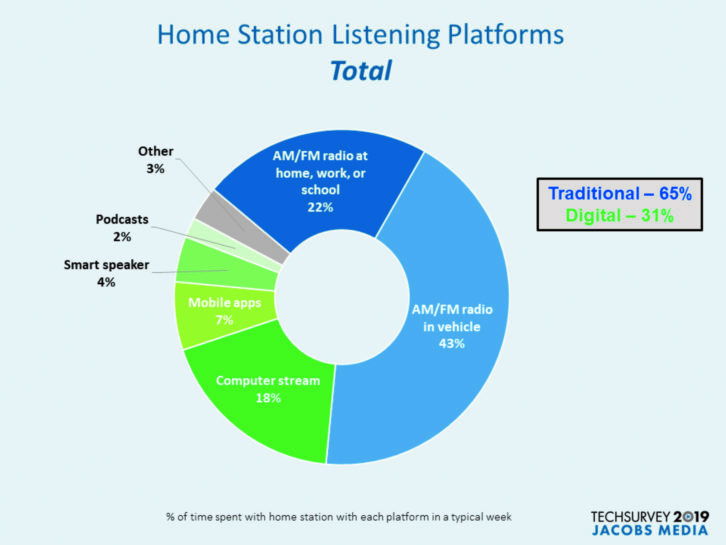
The impact of on-demand entertainment options like podcasts, Netflix, Hulu and YouTube TV had become more significant by then, with podcasting and other on-demand options being driven by millennials; 31% of Gen Y respondents said they listen to podcasts weekly.
“Young people were way into TV on demand sooner than anyone else obviously,” he said. “And if a person is into video on demand, they are also likely to be into audio on demand, better known as podcasting.”
Listening in connected cars, like those with Ford’s Sync Connect, became more fragmented by 2016. AM/FM listening was at 55%, while satellite radio, personal music on phones, podcasts, Pandora and audio books accounted for the rest.
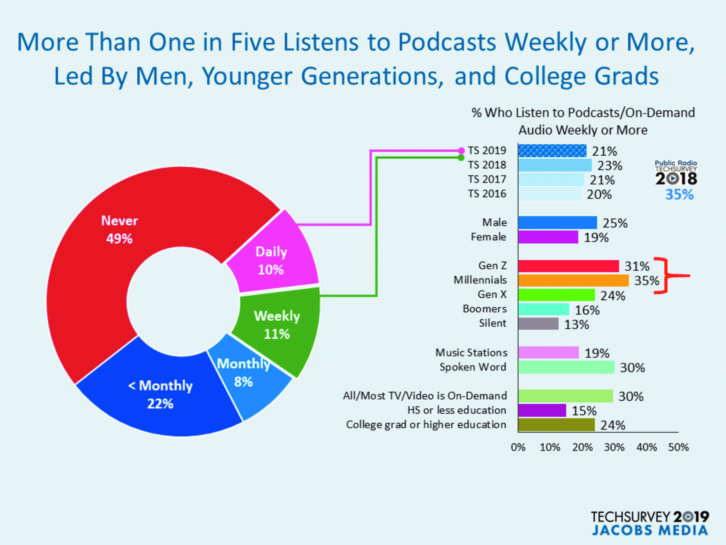
The 2017 survey shed more light on why people are still listening to AM/FM radio despite having so many other options. Jacobs said the answer is easy: “Because it’s free. And surprisingly, it’s the younger demos, perhaps because they are the most cash-strapped, which appreciate the fact that radio is free. And more are cutting the cord and moving away from premium pay services.”
Radio listening continued in 2017 to tip from traditional terrestrial on-air listening (74%) toward more digital listening via streams (22%).
“Most digital listeners are still streaming off a radio station’s website, but more and more are accessing the stations app,” Jacobs said, “which means it’s becoming more and more critical for radio stations to have a Millennial or Gen Z strategy. And smart speakers and the voice command feature on devices have become a big thing by 2017.”
Jacob Media’s brand pyramid in the 2018 survey showed significant growth by Hulu, Amazon Prime Video and Netflix, Jacobs said, as on-demand video streaming exploded. Radio was still the top “brand” (92%); but for the first time the survey asked about the most important features in a new connected car, and it differentiated between AM and FM radio.
“FM radio is the more important new car feature in the dash (81%), but only 37% say AM radio is a must-have in [their] next car. Things like Bluetooth connectivity (72%) and smartphone aux connector is (63%) are growing in demand,” Jacobs said.
The most recent survey, released in 2019, revealed growing privacy concerns among listeners, especially via home speakers and social media platforms such as Facebook.
“Nearly a quarter of those surveyed said they were seriously considering deleting Facebook due to privacy concerns. And we are seeing a connection to a decline of the number of people willing to sign up for a radio station’s stream. We think privacy is a big reason why fewer people are willing to sign up for the stream and provide us information,” Jacobs said.
In addition, a big conclusion of the latest survey is that satellite radio is making a strong comeback, he said.
SiriusXM “bought Pandora. They also have a great program with Amazon so that now you can listen to any SiriusXM channel on an Amazon Echo device. Now nearly one in four respondents in 2019 subscribed to satellite radio. And the top two options for satellite radio subscribers are the spoken word, sports and news/talk programming.”
Jacobs said Techsurvey this year will delve deeper into smart speakers and voice control, podcasting and CarPlay and Android Auto in the dashboard, as well as “hearables” — smart headphones — such as AirPods.





